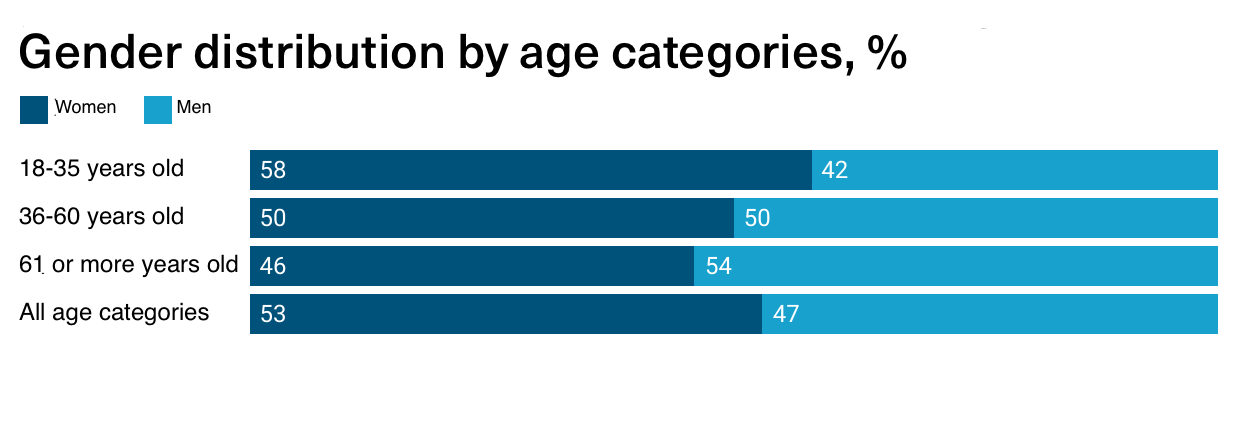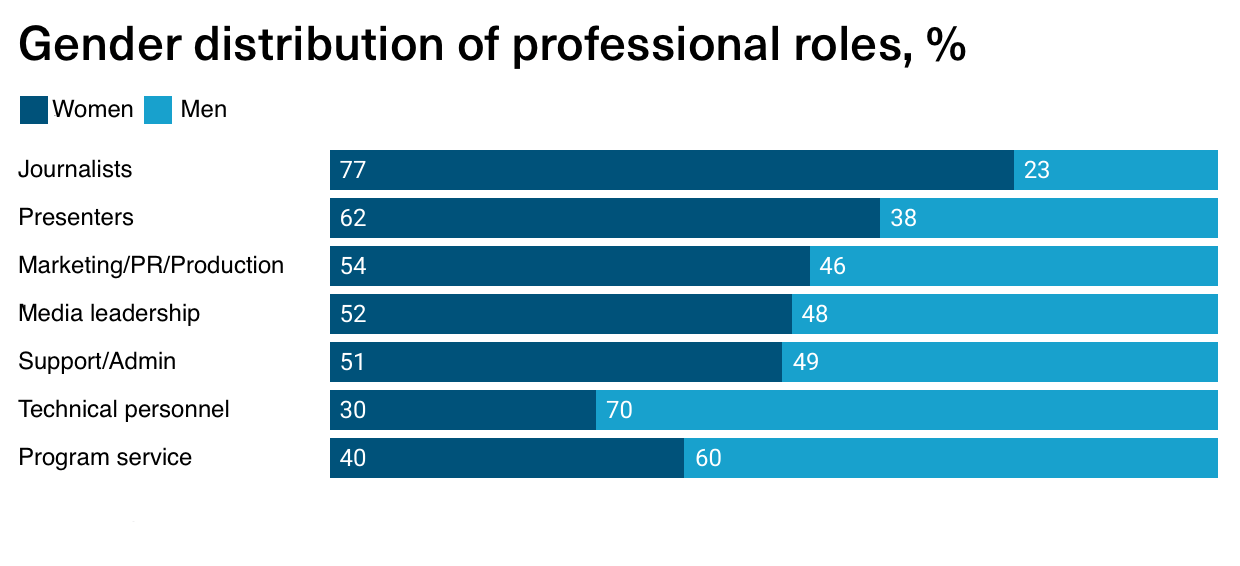77% of journalists in Ukraine are women. Furthermore, women outnumber men in nearly all professions within the media sphere. But is numerical dominance the main factor in ensuring gender balance? Does greater representation truly shape equal attitudes towards women and equal opportunities for them?
Achieving gender equality, particularly in the labor market, is a necessity within the framework of European integration processes. The media sphere is no exception and requires significant changes in approaches to implementing gender equality and increasing the level of women’s representation. This is important because the media influence societal perceptions and often shape (or, conversely, debunk) prejudices and stereotypes.
In 2023, the NGO Women in Media conducted two studies on gender balance in Ukrainian media organizations. For the first time in Ukraine, the analysis focused on the structure of newsroom teams rather than content.
- The study “Gender Profile of Ukrainian Media” was conducted in collaboration with Ukraine’s National Council on Television and Radio Broadcasting. A total of 206 media companies engaged in television, radio broadcasting, or both were analyzed in this study. These companies employ a total of 4,820 individuals. The study examined the gender ratios in various types of media, different positions, and across different age groups.
- The study “Gender Balance on Decision-Making in Ukraine’s Media Organizations” directly investigated gender balance within media outlets in Ukraine. It involved 173 respondents from 164 organizations. Of these organizations, 47% were online publications, 24% were print media, 15% were multimedia platforms, 9% were television, and 5% were radio. This study focused on analyzing gender balance indicators, including gender representation in leadership positions, women’s participation in decision-making within media organizations, and the presence of gender equality policies in Ukrainian newsrooms.
Next, the results of these studies are briefly presented.
Findings of the study “Gender Profile of Ukrainian Media”
The study “Gender Profile of Ukrainian Media” revealed that women outnumber men in the TV and radio industry, with a total of 53% of media employees being women, and the highest percentage of women among journalists at 77%. The numerical advantage of women is more pronounced in younger age groups, with 58% of women in the 18-38 age group, 50% in the 35-60 age group, and 46% among individuals aged 61 and older. Therefore, it can be assumed that the proportion of women in the media will continue to grow in the future.
In the industry under study, there is a noticeable stereotypical gender distribution of roles. Women dominate in more creative and artistic professions, with 77% among journalists, 62% among presenters, and 54% in marketing and public relations. The smallest percentage of women hold technical and programming staff positions at 30% and 40%, respectively. In media leadership, women make up 52%, which is significantly lower than among journalists. However, in the European Union, on average, only 35% of media executives are women.
The study also revealed that the percentages of men and women receiving social benefits from their employers are nearly equal, while support in the form of flexible work schedules is slightly more common among women. However, the largest gap is observed in maternity leave, with 54% of women receiving it compared to only 17% of men.
Nevertheless, gender disparity can manifest not only in the proportion of women in specific positions but also in the gender pay gap for equivalent roles. Unfortunately, the research being discussed does not address the topic of salaries. However, the National Strategy for Reducing the Gender Pay Gap in Ukraine for the period up to 2030 suggests implementing gender quotas for leadership positions and allocating resources to support women’s career development.
Findings of the study “Gender Balance in Decision-Making in Ukraine’s Media Organizations”
In the study “Gender Balance on Decision-Making in Ukraine’s Media Organizations,” which was based on 173 surveys from 168 organizations, three main indicators of gender balance were considered: the ratio of women to men in top positions within the internal and external governance bodies of organizations, as well as the presence of gender equality policies. These indicators are applied by the European Institute for Gender Equality when analyzing the gender balance within media organizations.
41% of the surveyed newsrooms reported that women hold all leadership positions related to strategy development. In comparison, 6% have no female top managers at all (11% of the respondents were unaware of the gender distribution within the management of their newsroom teams, and the remaining respondents stated that women were present in varying numbers). The situation differs somewhat in regional media, as 17 regional media outlets (about 20% of those surveyed) reported having no women in their newsrooms.
Women lead media advisory bodies in 57% of cases, while men are in charge of such bodies in 38% of media organizations. Another 5% of respondents indicated they were unsure who leads the advisory bodies in their newsrooms.
Among media owners, men slightly outnumber women, with women being the ultimate beneficiaries of media ownership in 25% of media outlets, while men account for 38%. The remaining respondents indicated that they did not know who owned the media (2.3% of respondents) or that the owners were a group of individuals (34.7%).
Overall, the representation of women in leadership positions is influenced by two main factors: the size of the media organization and the specific leadership role. In larger media outlets with more than two individuals in leadership positions, men are more likely to occupy those roles. The significant presence of women at the helm of small newsroom teams may be related to the fact that smaller regional media outlets, especially print media, cannot offer high salaries.
At the same time, the representation of women in managerial positions depends on the sphere of responsibility. Women occupy half or more of the leadership positions related to finance, procurement, and tender documentation in 93% of media organizations. They also hold half or more of the leadership positions involved in shaping editorial policies, content planning, and format development in 88% of media organizations. Additionally, women hold half or more of the leadership positions related to developing and implementing strategies in 81% of media outlets.
The high level of female involvement in leadership positions can be partially explained by the fact that the majority of the media outlets participating in the study are online media and media platforms. These are relatively new in the market and are less prone to established practices and biases.
Comparisons with Europe
The situation in the Ukrainian media market differs from that in Europe. For example, in the UK in 2022, the percentage of women among journalists was 41%.
While in European Union countries, men tend to outnumber women in the media industry, the situation in Ukraine is the opposite. This could be attributed to factors such as low salaries and the perception of journalism as a humanities-related or “feminine” field.
Therefore, it is crucial to intelligently adopt European practices for promoting gender equality. Unlike EU countries, the focus in Ukraine should not solely be on increasing the number of women in the media but also on implementing policies for their professional growth and ensuring accurate representation of women in media output.
Due to the significant presence of women in newsrooms, it might seem that gender equality issues are not relevant in the media sector. This could be why policies for equal opportunities are in place in only 24% of newsroom teams. However, these policies are essential for increasing gender equality in areas and professions where there may be an imbalance. One component of achieving gender equality could be policies promoting transparent wage structures, i.e., documents clearly outlining the compensation for specific roles. Currently, only 21% of surveyed media outlets have such policies.
Only 18% of the surveyed media outlets employ a consultant or another responsible person to contact in case of a discriminatory situation or have developed a set of actions to follow when such situations occur.
Conclusions and recommendations
The full-scale invasion and a range of other economic and social factors significantly impact the shift in gender distribution in the labor market. In the media industry, among younger age groups, the percentage of women exceeds 50%, particularly in leadership positions. With appropriate policies and approaches in place, this fact can enhance the qualitative representation of women in the media.
We propose the following recommendations for achieving gender balance:
- Collecting and analyzing gender-disaggregated data. More comprehensive research to study wage distribution, women’s motivations to work in the media, their representation in large media conglomerates, the effectiveness of implemented equality policies, etc., could serve as a basis for developing more relevant policies for Ukraine.
- Regular calculation of gender indicators at both national and corporate levels to assess changes in gender equality in the media industry.
- Encouraging media owners and leadership to develop gender policies and integrate them into the company’s corporate culture.
- Implementing monitoring mechanisms for achieving equal representation within companies: systematic reviews and reporting on wage levels and promotions for both women and men, transparent hiring practices.
- Including gender equality experts on the staff of media companies and establishing regular collaborations with such experts on a contractual basis for smaller media outlets.
Attention
The author doesn`t work for, consult to, own shares in or receive funding from any company or organization that would benefit from this article, and have no relevant affiliations






